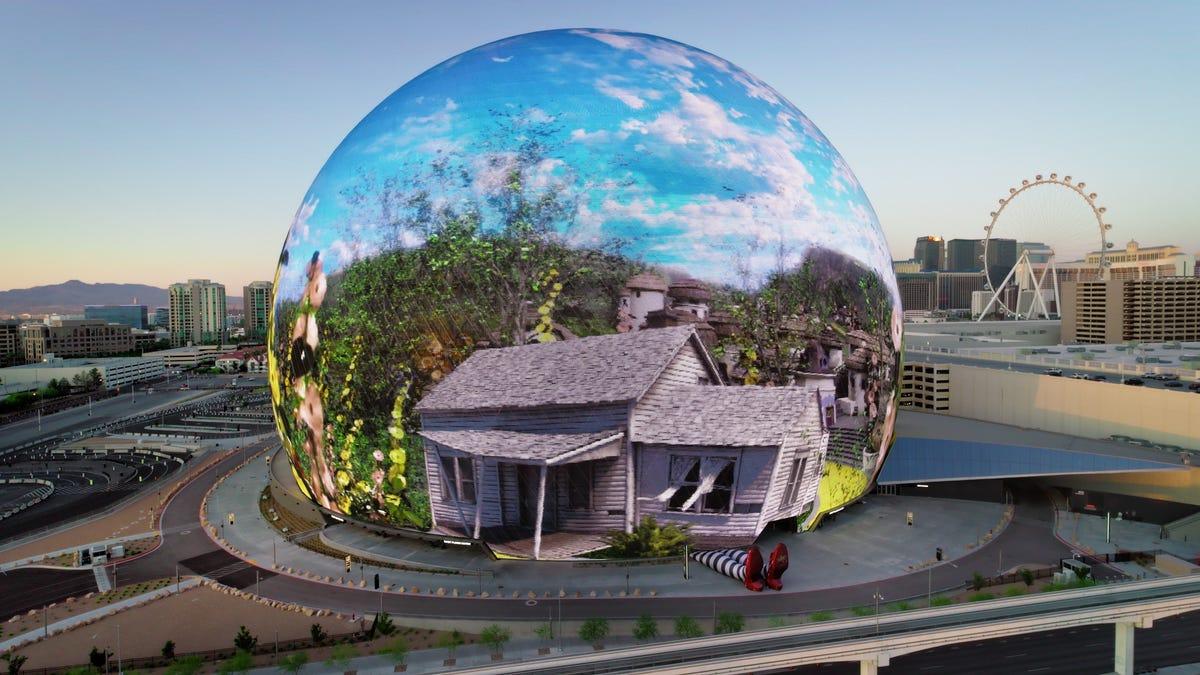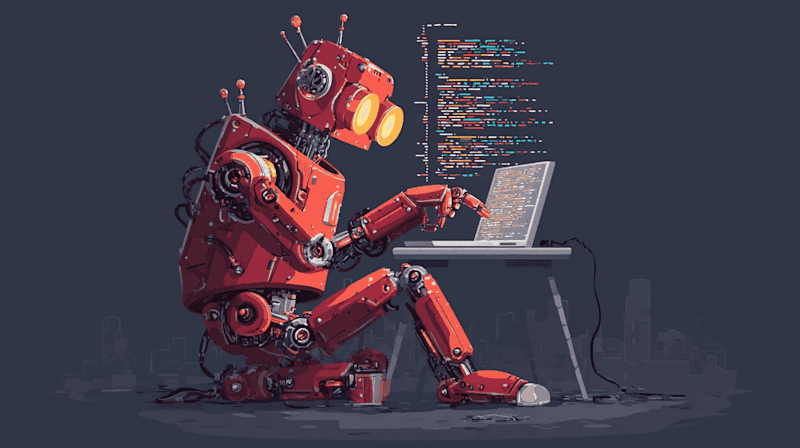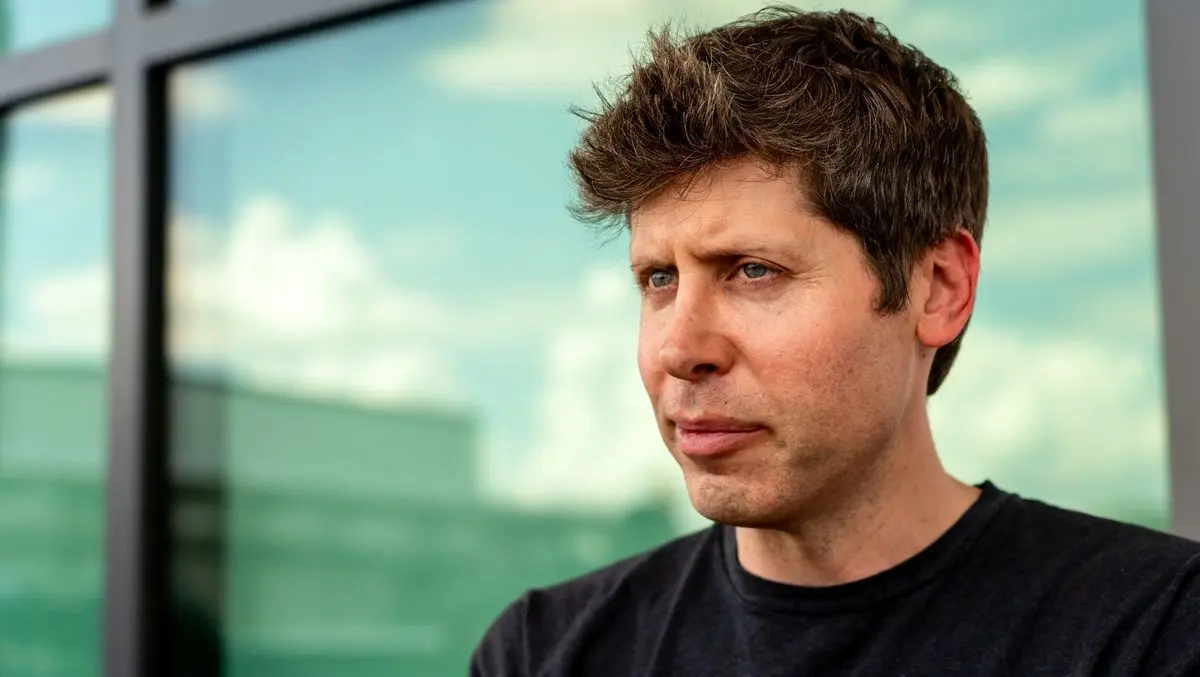AI Reimagines 'The Wizard of Oz' for Las Vegas Sphere: A Landmark Collaboration in Entertainment Technology
4 Sources
4 Sources
[1]
Hollywood's biggest AI debut? Las Vegas Sphere's 'Wizard of Oz'
LAS VEGAS, Aug 21 (Reuters) - When "The Wizard of Oz at Sphere" opens off the Las Vegas Strip on Aug. 28, audiences will experience the 1939 film classic in a way its creators probably never thought possible. Nearly 18,000 people will find themselves in the eye of the swirling tornado that rips Dorothy's Kansas farmhouse off its moorings and hurtles it onto Munchkinland. The film has been enhanced to fill a 160,000-square-foot wall of LED panels that spans three football fields, encircling the audience and reaching 22 stories high, as 750-horsepower fans kick up wind and debris to simulate the twister. The $104 or more per seat spectacle is more than meets the eye. "The Wizard of Oz" marks one of the most significant partnerships between a studio and technology company to use artificial intelligence to forge a new media experience. Reuters spoke with nine people, including principals directly involved in the project and senior entertainment industry experts, who told the story behind a project that some industry veterans see as a potential watershed moment in Hollywood's use of AI tools. "It definitely represents a really meaningful milestone in AI-human creative collaboration," said Thao Nguyen, immersive arts and emerging technologies agent at CAA. "I think it will set a precedent on how we reimagine culturally significant media." Bringing Dorothy and the Wicked Witch to the massive Sphere, a globe-shaped entertainment venue featuring advanced technology, took two years and brought together its creative team, Warner Bros Discovery executives, Google's DeepMind researchers, academics, visual effects artists -- more than 2,000 people, in all. The development occurred during intense apprehension over AI's impact on jobs in Hollywood and the desire to preserve human creativity. Some visual effects companies initially contacted to work on the project declined because they were not permitted to work with AI at the time. 'YOU'RE TOAST!' Getting here took the blessing of Warner Bros Discovery CEO David Zaslav, his studio chiefs and lawyers who established guidelines for using AI. "Wizard of Oz at Sphere" drew upon archival materials from the film -- including set blueprints, shot lists, publicity stills and film artifacts -- as well as some 60 research papers to help deliver the movie in resolution representing a ten-fold improvement over previous work. "We had to reimagine the cinematography, we had to reimagine the editing, and we had to do all of this without changing the experience," said Oscar-winner Ben Grossmann, who oversaw the project's visual effects. "Because if you touch anything about this sacred piece of cinema, you're toast!" Rather than exploiting AI to cut jobs, they sought to use it to breathe fresh life into a classic story and create new experiences with existing intellectual property. "Hollywood embraces new technology, and everyone can't wait to be the second one to use it," said Buzz Hays, a veteran film producer who leads Google Cloud's entertainment industry solutions group. "What 'The Wizard of Oz' is doing for us is giving that first opportunity where people go, 'Oh my god, this is not at all what I thought AI was going to be.'" The project began in 2023 with Sphere executives discussing which project would push the technological boundaries of the venue that had already hosted U2 and Darren Aronofsky's "Postcard from Earth." "The Wizard of Oz" quickly topped the list as a familiar, beloved film well-suited for the Sphere's enormous canvas, said Carolyn Blackwood, head of Sphere Studios. It presented an opportunity to re-introduce the classic to a new generation in a way that would place them inside L. Frank Baum's world. Symbolically, the team chose a classic film that was a technical marvel of its time. While not the first movie to use Technicolor, "The Wizard of Oz's" dramatic transition from sepia tones to hyper-saturated color marked a cinematic milestone. Sphere Entertainment's CEO James Dolan and creative collaborator Jane Rosenthal, Tribeca Film Festival co-founder and noted film producer, envisioned a more ambitious project than a mere digital remastering of a classic. Rosenthal tapped Hays to bring in Google as a technical partner. AI 'QUARANTINE ZONE' Dolan approached Warner Bros Discovery CEO Zaslav, a friend and business partner from the early days of cable TV, to propose bringing "Oz" to the Sphere. "I had just been to the Sphere with a friend and was really blown away," said Zaslav, adding that Dolan and Rosenthal also won over his studio chiefs, "who loved the idea. It's an example of the great IP we own at Warner Bros." Before turning over one of the world's most important entertainment properties, Warner Bros set strict ground rules. Google could train its generative AI models on each major actor to reproduce their performances, but the data would remain the studio's property. None of the "Oz" training data would be incorporated into Google's public AI models. "One of the things critical to getting this project started was creating a safe place for experimentation," said Grossmann. "Warner Brothers and Google and the Sphere created an environment where they said, 'We don't necessarily know how it's going to end, but we're going to create a little quarantine zone here.'" The visual effects team initially tried enlarging images using CGI, which would have created photorealistic animated versions of the characters. That approach was rejected because it would violate the integrity of the original performances. "AI was effectively a last resort, because we couldn't really do it any other way," said Grossmann, whose Los Angeles studio, Magnopus, worked on such photo-realistic computer animated films as Disney's "The Lion King." AI enhanced the resolution of tiny celluloid frames from 1939 to ultra-high-definition images. It restored details -- like freckles on Dorothy's face or burlap texture on Scarecrow's face -- obscured by Technicolor's process. AI also helped "outpaint" on-screen images to fill gaps created by camera cuts or framing, as when it took a close-up of the Tin Man chopping a door of the Witch's castle with an axe to free Dorothy and completed the image of the woodman. It took months of repeated fine-tuning and Google's DeepMind braintrust to elevate consumer-grade AI tools to deliver crisp images with the Sphere's 16K "super" resolution. Musicians re-recorded the entire film score on the original sound stage to take advantage of the venue's 167,000 speakers. The vocal performances of Judy Garland and other actors remain unaltered. FLYING MONKEYS Despite attention to authenticity, the project has attracted criticism from some cinephiles who object to altering the cherished film. Entertainment writer Joshua Rivera called it "an affront to art and nature." "None of these people criticizing this have seen the film or understand what we are doing," said Rosenthal. In a private midnight screening for Reuters, Grossmann offered a glimpse of what's to come. Some changes are subtle, as when Uncle Henry stands by the front door while neighbor Almira Gulch demands Toto. AI places the performer, who spends much of his time out of view, back into frame, stitching together a wider view to fill the Sphere's expansive viewing plane. Other changes aim to realize the filmmakers' vision in ways that weren't technically feasible 86 years ago. As Dorothy and friends encounter the Wizard in the Emerald Throne Room, a 200-foot-high green head looms over the audience, eyes bulging and voice booming, creating a more imposing depiction than the original image of an actor in green makeup projected on smoke. "Whenever we made a change, it was because we wanted the audience to experience what Dorothy was experiencing directly," said Grossmann. "We completed something filmmakers were intending to do but were limited by 1939's tools . Coordinated physical effects add another dimension. Flying monkeys will swoop into the Sphere as 16-foot-long helium-filled simians steered by drone operators, one of many Four-D effects. The result is an amalgam of cinema, live production and experiential VR. "I think that's going to change the way people think about entertainment and experience," Grossmann said. Editing by Anna Driver and Ken Li Our Standards: The Thomson Reuters Trust Principles., opens new tab
[2]
Hollywood's Biggest AI Debut? Las Vegas Sphere's 'Wizard of Oz'
LAS VEGAS (Reuters) -When "The Wizard of Oz at Sphere" opens off the Las Vegas Strip on Aug. 28, audiences will experience the 1939 film classic in a way its creators probably never thought possible. Nearly 18,000 people will find themselves in the eye of the swirling tornado that rips Dorothy's Kansas farmhouse off its moorings and hurtles it onto Munchkinland. The film has been enhanced to fill a 160,000-square-foot wall of LED panels that spans three football fields, encircling the audience and reaching 22 stories high, as 750-horsepower fans kick up wind and debris to simulate the twister. The $104 or more per seat spectacle is more than meets the eye. "The Wizard of Oz" marks one of the most significant partnerships between a studio and technology company to use artificial intelligence to forge a new media experience. Reuters spoke with nine people, including principals directly involved in the project and senior entertainment industry experts, who told the story behind a project that some industry veterans see as a potential watershed moment in Hollywood's use of AI tools. "It definitely represents a really meaningful milestone in AI-human creative collaboration," said Thao Nguyen, immersive arts and emerging technologies agent at CAA. "I think it will set a precedent on how we reimagine culturally significant media." Bringing Dorothy and the Wicked Witch to the massive Sphere, a globe-shaped entertainment venue featuring advanced technology, took two years and brought together its creative team, Warner Bros Discovery executives, Google's DeepMind researchers, academics, visual effects artists -- more than 2,000 people, in all. The development occurred during intense apprehension over AI's impact on jobs in Hollywood and the desire to preserve human creativity. Some visual effects companies initially contacted to work on the project declined because they were not permitted to work with AI at the time. 'YOU'RE TOAST!' Getting here took the blessing of Warner Bros Discovery CEO David Zaslav, his studio chiefs and lawyers who established guidelines for using AI. "Wizard of Oz at Sphere" drew upon archival materials from the film -- including set blueprints, shot lists, publicity stills and film artifacts -- as well as some 60 research papers to help deliver the movie in resolution representing a ten-fold improvement over previous work. "We had to reimagine the cinematography, we had to reimagine the editing, and we had to do all of this without changing the experience," said Oscar-winner Ben Grossmann, who oversaw the project's visual effects. "Because if you touch anything about this sacred piece of cinema, you're toast!" Rather than exploiting AI to cut jobs, they sought to use it to breathe fresh life into a classic story and create new experiences with existing intellectual property. "Hollywood embraces new technology, and everyone can't wait to be the second one to use it," said Buzz Hays, a veteran film producer who leads Google Cloud's entertainment industry solutions group. "What 'The Wizard of Oz' is doing for us is giving that first opportunity where people go, 'Oh my god, this is not at all what I thought AI was going to be.'" The project began in 2023 with Sphere executives discussing which project would push the technological boundaries of the venue that had already hosted U2 and Darren Aronofsky's "Postcard from Earth." "The Wizard of Oz" quickly topped the list as a familiar, beloved film well-suited for the Sphere's enormous canvas, said Carolyn Blackwood, head of Sphere Studios. It presented an opportunity to re-introduce the classic to a new generation in a way that would place them inside L. Frank Baum's world. Symbolically, the team chose a classic film that was a technical marvel of its time. While not the first movie to use Technicolor, "The Wizard of Oz's" dramatic transition from sepia tones to hyper-saturated color marked a cinematic milestone. Sphere Entertainment's CEO James Dolan and creative collaborator Jane Rosenthal, Tribeca Film Festival co-founder and noted film producer, envisioned a more ambitious project than a mere digital remastering of a classic. Rosenthal tapped Hays to bring in Google as a technical partner. AI 'QUARANTINE ZONE' Dolan approached Warner Bros Discovery CEO Zaslav, a friend and business partner from the early days of cable TV, to propose bringing "Oz" to the Sphere. "I had just been to the Sphere with a friend and was really blown away," said Zaslav, adding that Dolan and Rosenthal also won over his studio chiefs, "who loved the idea. It's an example of the great IP we own at Warner Bros." Before turning over one of the world's most important entertainment properties, Warner Bros set strict ground rules. Google could train its generative AI models on each major actor to reproduce their performances, but the data would remain the studio's property. None of the "Oz" training data would be incorporated into Google's public AI models. "One of the things critical to getting this project started was creating a safe place for experimentation," said Grossmann. "Warner Brothers and Google and the Sphere created an environment where they said, 'We don't necessarily know how it's going to end, but we're going to create a little quarantine zone here.'" The visual effects team initially tried enlarging images using CGI, which would have created photorealistic animated versions of the characters. That approach was rejected because it would violate the integrity of the original performances. "AI was effectively a last resort, because we couldn't really do it any other way," said Grossmann, whose Los Angeles studio, Magnopus, worked on such photo-realistic computer animated films as Disney's "The Lion King." AI enhanced the resolution of tiny celluloid frames from 1939 to ultra-high-definition images. It restored details -- like freckles on Dorothy's face or burlap texture on Scarecrow's face -- obscured by Technicolor's process. AI also helped "outpaint" on-screen images to fill gaps created by camera cuts or framing, as when it took a close-up of the Tin Man chopping a door of the Witch's castle with an axe to free Dorothy and completed the image of the woodman. It took months of repeated fine-tuning and Google's DeepMind braintrust to elevate consumer-grade AI tools to deliver crisp images with the Sphere's 16K "super" resolution. Musicians re-recorded the entire film score on the original sound stage to take advantage of the venue's 167,000 speakers. The vocal performances of Judy Garland and other actors remain unaltered. FLYING MONKEYS Despite attention to authenticity, the project has attracted criticism from some cinephiles who object to altering the cherished film. Entertainment writer Joshua Rivera called it "an affront to art and nature." "None of these people criticizing this have seen the film or understand what we are doing," said Rosenthal. In a private midnight screening for Reuters, Grossmann offered a glimpse of what's to come. Some changes are subtle, as when Uncle Henry stands by the front door while neighbor Almira Gulch demands Toto. AI places the performer, who spends much of his time out of view, back into frame, stitching together a wider view to fill the Sphere's expansive viewing plane. Other changes aim to realize the filmmakers' vision in ways that weren't technically feasible 86 years ago. As Dorothy and friends encounter the Wizard in the Emerald Throne Room, a 200-foot-high green head looms over the audience, eyes bulging and voice booming, creating a more imposing depiction than the original image of an actor in green makeup projected on smoke. "Whenever we made a change, it was because we wanted the audience to experience what Dorothy was experiencing directly," said Grossmann. "We completed something filmmakers were intending to do but were limited by 1939's tools . Coordinated physical effects add another dimension. Flying monkeys will swoop into the Sphere as 16-foot-long helium-filled simians steered by drone operators, one of many Four-D effects. The result is an amalgam of cinema, live production and experiential VR. "I think that's going to change the way people think about entertainment and experience," Grossmann said. (Editing by Anna Driver and Ken Li)
[3]
Hollywood's biggest AI debut as 'Wizard of Oz' hits Las Vegas Sphere
When "The Wizard of Oz at Sphere" opens off the Las Vegas strip in August, audiences will experience the 1939 film classic in a way its creators never thought possible. It marks one of the most significant partnerships between a studio and technology company to use artificial intelligence. ''We had to reimagine the cinematography. We had to reimagine the editing. And we had to do all of this without changing the experience. Because if you touch anything about that sacred piece of cinema, you're toast." Nearly 18,000 people will be sent into the eye of the swirling tornado that hurtles Dorothy onto the yellow brick road of Munchkinland... ...the original film enhanced to fill a 160,000-square-foot wall of LED panels, encircling the audience as fans kick up wind and debris to simulate the twister. Oscar winner and CEO of Magnopus, Ben Grossmann, oversaw the visual effects for the project. "At the Sphere, you see everything. So we broke the problem up into: We need to drastically increase the resolution and detail of the original movie, we need to complete the missing parts of the people who were cut off and then we need to create the continuity of the scene so that the performances that you know are there are actually there." :: Sphere Entertainment Involving Warner Bros Discovery, Google's DeepMind and more than 2,000 collaborators, there were strict ground rules for using AI. Google could train its generative AI models on each major actor to reproduce their performances, but the data would remain the Warner Brothers' property. None of the "Oz" training data would be incorporated into Google's public AI models. "The AI never generated anything by itself. It was always guided, carefully instructed, supported, nurtured, coaxed, cajoled by an artist who knew what they were trying to get out of it. And I think that now that those tools have become - at first you try to make it possible, and then you try and make it efficient - what we're doing is possible, barely. The next step will be making it efficient." :: Sphere Entertainment The development faced intense apprehension over the impact on Hollywood jobs and the desire to preserve human creativity. Producer Jane Rosenthal says that was expected. "Whenever you want to push something in an artistic form, in a new way, there are always critics. None of these people that are criticizing this have seen the film or understand what we are doing in this medium, and none of them understand our love of the film."
[4]
Hollywood's biggest AI debut? Las Vegas Sphere's 'Wizard of Oz'
LAS VEGAS (Reuters) -When "The Wizard of Oz at Sphere" opens off the Las Vegas Strip on Aug. 28, audiences will experience the 1939 film classic in a way its creators probably never thought possible. Nearly 18,000 people will find themselves in the eye of the swirling tornado that rips Dorothy's Kansas farmhouse off its moorings and hurtles it onto Munchkinland. The film has been enhanced to fill a 160,000-square-foot wall of LED panels that spans three football fields, encircling the audience and reaching 22 stories high, as 750-horsepower fans kick up wind and debris to simulate the twister. The $104 or more per seat spectacle is more than meets the eye. "The Wizard of Oz" marks one of the most significant partnerships between a studio and technology company to use artificial intelligence to forge a new media experience. Reuters spoke with nine people, including principals directly involved in the project and senior entertainment industry experts, who told the story behind a project that some industry veterans see as a potential watershed moment in Hollywood's use of AI tools. "It definitely represents a really meaningful milestone in AI-human creative collaboration," said Thao Nguyen, immersive arts and emerging technologies agent at CAA. "I think it will set a precedent on how we reimagine culturally significant media." Bringing Dorothy and the Wicked Witch to the massive Sphere, a globe-shaped entertainment venue featuring advanced technology, took two years and brought together its creative team, Warner Bros Discovery executives, Google's DeepMind researchers, academics, visual effects artists -- more than 2,000 people, in all. The development occurred during intense apprehension over AI's impact on jobs in Hollywood and the desire to preserve human creativity. Some visual effects companies initially contacted to work on the project declined because they were not permitted to work with AI at the time. 'YOU'RE TOAST!' Getting here took the blessing of Warner Bros Discovery CEO David Zaslav, his studio chiefs and lawyers who established guidelines for using AI. "Wizard of Oz at Sphere" drew upon archival materials from the film -- including set blueprints, shot lists, publicity stills and film artifacts -- as well as some 60 research papers to help deliver the movie in resolution representing a ten-fold improvement over previous work. "We had to reimagine the cinematography, we had to reimagine the editing, and we had to do all of this without changing the experience," said Oscar-winner Ben Grossmann, who oversaw the project's visual effects. "Because if you touch anything about this sacred piece of cinema, you're toast!" Rather than exploiting AI to cut jobs, they sought to use it to breathe fresh life into a classic story and create new experiences with existing intellectual property. "Hollywood embraces new technology, and everyone can't wait to be the second one to use it," said Buzz Hays, a veteran film producer who leads Google Cloud's entertainment industry solutions group. "What 'The Wizard of Oz' is doing for us is giving that first opportunity where people go, 'Oh my god, this is not at all what I thought AI was going to be.'" The project began in 2023 with Sphere executives discussing which project would push the technological boundaries of the venue that had already hosted U2 and Darren Aronofsky's "Postcard from Earth." "The Wizard of Oz" quickly topped the list as a familiar, beloved film well-suited for the Sphere's enormous canvas, said Carolyn Blackwood, head of Sphere Studios. It presented an opportunity to re-introduce the classic to a new generation in a way that would place them inside L. Frank Baum's world. Symbolically, the team chose a classic film that was a technical marvel of its time. While not the first movie to use Technicolor, "The Wizard of Oz's" dramatic transition from sepia tones to hyper-saturated color marked a cinematic milestone. Sphere Entertainment's CEO James Dolan and creative collaborator Jane Rosenthal, Tribeca Film Festival co-founder and noted film producer, envisioned a more ambitious project than a mere digital remastering of a classic. Rosenthal tapped Hays to bring in Google as a technical partner. AI 'QUARANTINE ZONE' Dolan approached Warner Bros Discovery CEO Zaslav, a friend and business partner from the early days of cable TV, to propose bringing "Oz" to the Sphere. "I had just been to the Sphere with a friend and was really blown away," said Zaslav, adding that Dolan and Rosenthal also won over his studio chiefs, "who loved the idea. It's an example of the great IP we own at Warner Bros." Before turning over one of the world's most important entertainment properties, Warner Bros set strict ground rules. Google could train its generative AI models on each major actor to reproduce their performances, but the data would remain the studio's property. None of the "Oz" training data would be incorporated into Google's public AI models. "One of the things critical to getting this project started was creating a safe place for experimentation," said Grossmann. "Warner Brothers and Google and the Sphere created an environment where they said, 'We don't necessarily know how it's going to end, but we're going to create a little quarantine zone here.'" The visual effects team initially tried enlarging images using CGI, which would have created photorealistic animated versions of the characters. That approach was rejected because it would violate the integrity of the original performances. "AI was effectively a last resort, because we couldn't really do it any other way," said Grossmann, whose Los Angeles studio, Magnopus, worked on such photo-realistic computer animated films as Disney's "The Lion King." AI enhanced the resolution of tiny celluloid frames from 1939 to ultra-high-definition images. It restored details -- like freckles on Dorothy's face or burlap texture on Scarecrow's face -- obscured by Technicolor's process. AI also helped "outpaint" on-screen images to fill gaps created by camera cuts or framing, as when it took a close-up of the Tin Man chopping a door of the Witch's castle with an axe to free Dorothy and completed the image of the woodman. It took months of repeated fine-tuning and Google's DeepMind braintrust to elevate consumer-grade AI tools to deliver crisp images with the Sphere's 16K "super" resolution. Musicians re-recorded the entire film score on the original sound stage to take advantage of the venue's 167,000 speakers. The vocal performances of Judy Garland and other actors remain unaltered. FLYING MONKEYS Despite attention to authenticity, the project has attracted criticism from some cinephiles who object to altering the cherished film. Entertainment writer Joshua Rivera called it "an affront to art and nature." "None of these people criticizing this have seen the film or understand what we are doing," said Rosenthal. In a private midnight screening for Reuters, Grossmann offered a glimpse of what's to come. Some changes are subtle, as when Uncle Henry stands by the front door while neighbor Almira Gulch demands Toto. AI places the performer, who spends much of his time out of view, back into frame, stitching together a wider view to fill the Sphere's expansive viewing plane. Other changes aim to realize the filmmakers' vision in ways that weren't technically feasible 86 years ago. As Dorothy and friends encounter the Wizard in the Emerald Throne Room, a 200-foot-high green head looms over the audience, eyes bulging and voice booming, creating a more imposing depiction than the original image of an actor in green makeup projected on smoke. "Whenever we made a change, it was because we wanted the audience to experience what Dorothy was experiencing directly," said Grossmann. "We completed something filmmakers were intending to do but were limited by 1939's tools . Coordinated physical effects add another dimension. Flying monkeys will swoop into the Sphere as 16-foot-long helium-filled simians steered by drone operators, one of many Four-D effects. The result is an amalgam of cinema, live production and experiential VR. "I think that's going to change the way people think about entertainment and experience," Grossmann said.
Share
Share
Copy Link
Warner Bros Discovery and Google partner to bring the classic film 'The Wizard of Oz' to life using AI and cutting-edge technology at Las Vegas' Sphere, marking a significant milestone in AI-human creative collaboration in the entertainment industry.
A Technological Marvel Brings Oz to Life
In a groundbreaking fusion of classic cinema and cutting-edge technology, "The Wizard of Oz at Sphere" is set to debut on August 28 in Las Vegas, marking what many industry experts consider a watershed moment in Hollywood's use of artificial intelligence
1
2
. This ambitious project, a collaboration between Warner Bros Discovery and Google, has transformed the beloved 1939 film into an immersive spectacle that pushes the boundaries of entertainment technology1
2
.Immersive Experience on an Unprecedented Scale

Source: Market Screener
The Sphere, a globe-shaped entertainment venue, will house this extraordinary presentation. Audiences of up to 18,000 people will be enveloped by a 160,000-square-foot wall of LED panels, spanning three football fields and reaching 22 stories high
1
2
. The experience promises to be multisensory, with 750-horsepower fans simulating the iconic tornado scene, literally placing viewers in the heart of the action1
2
.AI: The Wizard Behind the Curtain
At the core of this project is the innovative use of artificial intelligence. Oscar-winner Ben Grossmann, who oversaw the visual effects, explains the challenge: "We had to reimagine the cinematography, we had to reimagine the editing, and we had to do all of this without changing the experience"
1
2
3
. The team used AI to enhance the resolution of the original 1939 celluloid frames to ultra-high-definition, increasing detail tenfold1
2
.A Collaborative Effort
The project brought together over 2,000 collaborators, including Warner Bros Discovery executives, Google's DeepMind researchers, academics, and visual effects artists
1
2
. This extensive team worked for two years to bring Dorothy and the Wicked Witch to the massive Sphere1
2
.Navigating AI in Hollywood
The development of "The Wizard of Oz at Sphere" occurred during a time of intense apprehension over AI's impact on jobs in Hollywood
1
2
. However, rather than exploiting AI to cut jobs, the project aimed to use it to breathe fresh life into a classic story and create new experiences with existing intellectual property1
2
.Related Stories
Strict Guidelines and the 'AI Quarantine Zone'
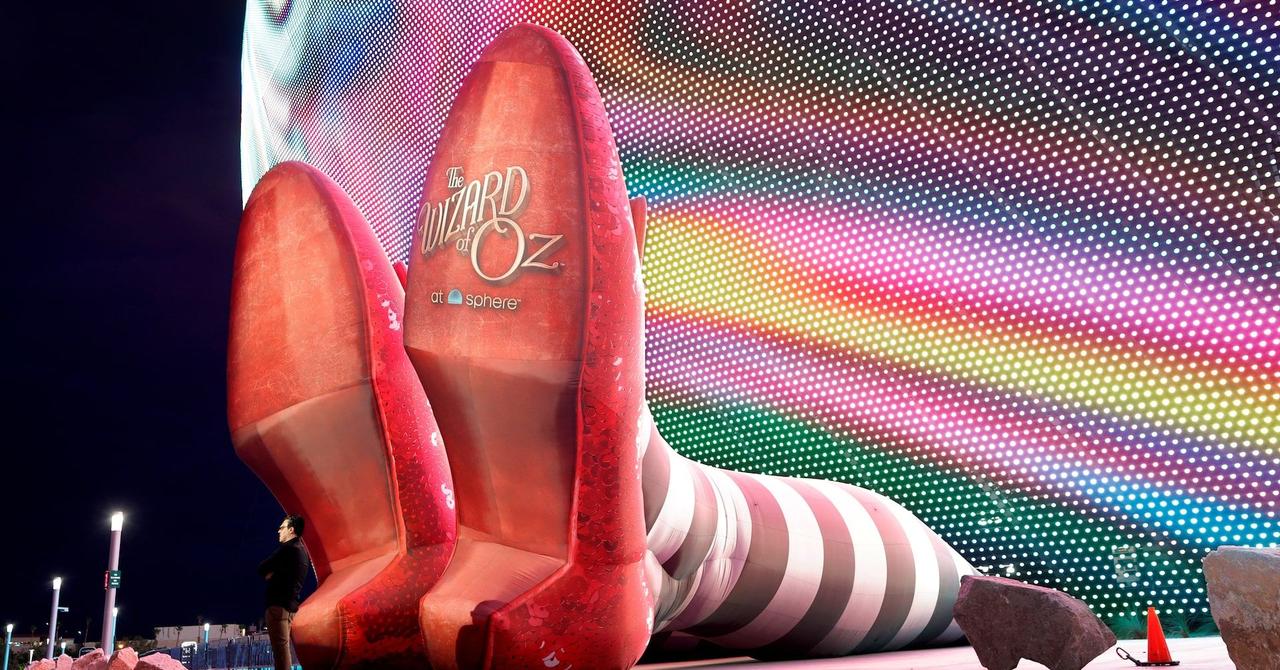
Source: Reuters
Warner Bros set strict ground rules for the use of AI in this project. Google was allowed to train its generative AI models on each major actor to reproduce their performances, but the data would remain Warner Bros' property
1
2
4
. A 'quarantine zone' was created to allow for safe experimentation without risking the integrity of the original work or Google's public AI models1
2
4
.A New Frontier in Entertainment
Thao Nguyen, immersive arts and emerging technologies agent at CAA, sees this project as "a really meaningful milestone in AI-human creative collaboration" that will "set a precedent on how we reimagine culturally significant media"
1
2
. Buzz Hays, who leads Google Cloud's entertainment industry solutions group, believes this project is "giving that first opportunity where people go, 'Oh my god, this is not at all what I thought AI was going to be'"1
2
.The Future of AI in Cinema
While some critics have expressed concerns about the use of AI in reimagining classic films, producer Jane Rosenthal defends the project, stating, "Whenever you want to push something in an artistic form, in a new way, there are always critics"
3
. As the entertainment industry continues to grapple with the implications of AI, "The Wizard of Oz at Sphere" stands as a testament to the potential for technology to enhance rather than replace human creativity in storytelling.References
Summarized by
Navi
[3]
[4]
Related Stories
Google's AI Reimagines 'The Wizard of Oz' for Las Vegas Sphere's Immersive Experience
09 Apr 2025•Technology
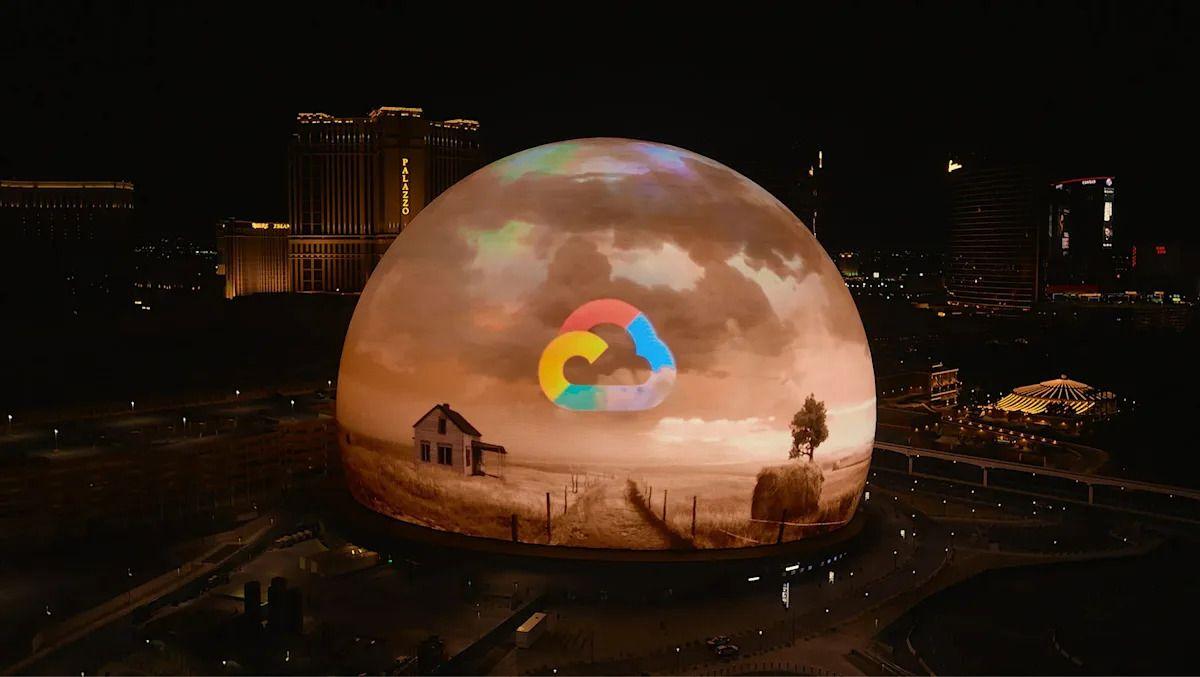
AI-Enhanced 'Wizard of Oz' Debuts at Las Vegas Sphere, Sparking Awe and Controversy
29 Aug 2025•Technology
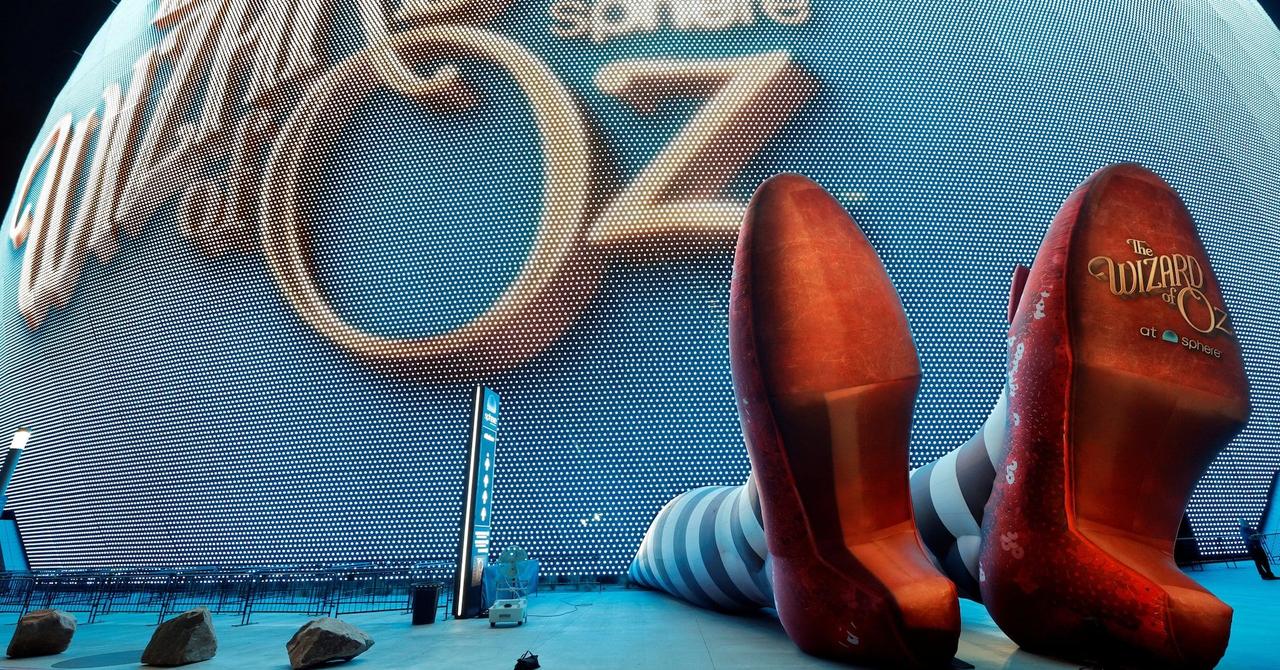
AI Transforms 'The Wizard of Oz' into Immersive 4D Experience at Las Vegas Sphere
28 Jul 2025•Entertainment and Society

Recent Highlights
1
Google launches Gemini 3 Flash as default AI model, delivering speed with Pro-grade reasoning
Technology

2
OpenAI launches GPT Image 1.5 as AI image generator war with Google intensifies
Technology

3
OpenAI launches ChatGPT app store, opening doors for third-party developers to build AI-powered apps
Technology

